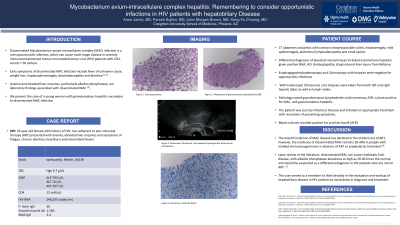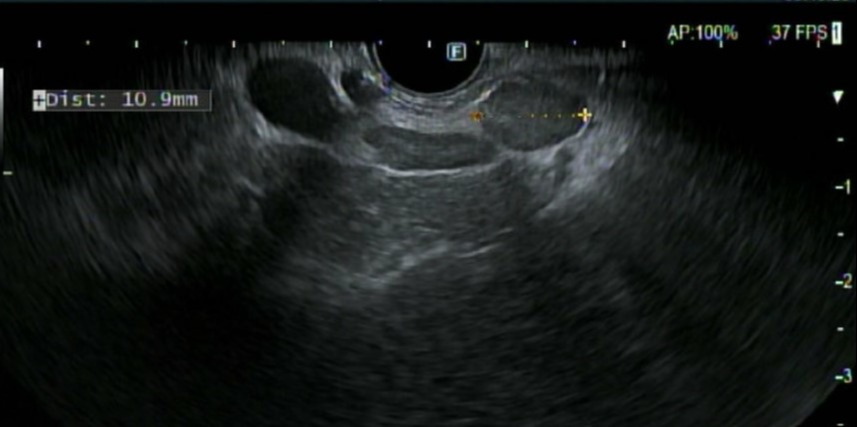Tuesday Poster Session
Category: Liver
P3879 - Mycobacterium Avium-Intracellulare Complex Hepatitis: Remembering to Consider Opportunistic Infections in HIV Patients With Hepatobiliary Disease
Tuesday, October 24, 2023
10:30 AM - 4:00 PM PT
Location: Exhibit Hall

Has Audio
.jpeg.jpg)
Anne Jarvis, MD
Creighton University
Phoenix, AZ
Presenting Author(s)
Anne Jarvis, MD1, Paresh M. Sojitra, MD2, Keng-Yu Chuang, MD3
1Creighton University, Phoenix, AZ; 2Creighton University, Chandler, AZ; 3Valleywise Health, Phoenix, AZ
Introduction: Disseminated Micobacterium Avium-Intracellulare Complex (MAC) infection is a rare opportunistic infection, which can cause multi-organ disease in severely immunocompromised human immunodeficiency virus (HIV) patients with CD4-counts < 50 cells/uL. Symptoms of disseminated MAC infection include fever of unknown cause, weight loss, hepatosplenomegaly, lymphadenopathy and diarrhea. Anemia and elevated liver enzymes, particularly alkaline phosphatase, are laboratory findings associated with disseminated MAC. We present the case of a young woman with granulomatous hepatitis secondary to disseminated MAC infection.
Case Description/Methods: 29-year-old female with HIV, non-adherent to anti-retroviral therapy (ART) presented with anemia, elevated liver enzymes and symptoms of fatigue, chronic diarrhea, heartburn and intermittent fevers. Patient was tachycardic, febrile, and had pale conjunctiva. Initial labs positive for Hgb 6.7 g/dL, CD4 12 cells/uL, alkaline phosphatase 793 U/L, ALT 70 U/L, AST 297 U/L, HIV RNA 246,235 copies/mL. Blood cultures positive for acid fast bacilli (AFB). CT abdomen and pelvis with contrast showed possible colitis, hepatomegaly, mild splenomegaly, abdominal lymphadenopathy. Esophagogastroduodenoscopy and Colonoscopy with biopsies were negative for opportunistic infections. With Endoscopic Ultrasound, core biopsies were taken from both left and right hepatic lobes as well as lymph nodes. Pathology noted granulomatous lymphadenitis with numerous AFB, culture positive for MAC, and granulomatous hepatitis. The patient was initiated on Fluconazole.
Discussion: The overall incidence of MAC disease has declined in the modern era of ART, however, the incidence of disseminated MAC remains 20-40% in people with marked immunosuppression in absence of ART or prophylactic treatment. Above is an interesting presentation of disseminated MAC infection in an immunocompromised patient with CD4 count of 12/mm3. Differential diagnosis of elevated transaminases includes autoimmune hepatitis with positive SMA, HIV-cholangiopathy, drug-induced-liver-injury from Biktarvy. Upon review of the literature, disseminated MAC can cause cholestatic liver disease, with alkaline phosphatase elevations as high as 20-40 times the normal, and should be suspected as a differential diagnosis in HIV patients who are not on ART. This case served as a reminder to think broadly in the evaluation and workup of hepatobiliary disease in HIV patients to avoid delay in diagnosis and treatment.

Disclosures:
Anne Jarvis, MD1, Paresh M. Sojitra, MD2, Keng-Yu Chuang, MD3. P3879 - Mycobacterium Avium-Intracellulare Complex Hepatitis: Remembering to Consider Opportunistic Infections in HIV Patients With Hepatobiliary Disease, ACG 2023 Annual Scientific Meeting Abstracts. Vancouver, BC, Canada: American College of Gastroenterology.
1Creighton University, Phoenix, AZ; 2Creighton University, Chandler, AZ; 3Valleywise Health, Phoenix, AZ
Introduction: Disseminated Micobacterium Avium-Intracellulare Complex (MAC) infection is a rare opportunistic infection, which can cause multi-organ disease in severely immunocompromised human immunodeficiency virus (HIV) patients with CD4-counts < 50 cells/uL. Symptoms of disseminated MAC infection include fever of unknown cause, weight loss, hepatosplenomegaly, lymphadenopathy and diarrhea. Anemia and elevated liver enzymes, particularly alkaline phosphatase, are laboratory findings associated with disseminated MAC. We present the case of a young woman with granulomatous hepatitis secondary to disseminated MAC infection.
Case Description/Methods: 29-year-old female with HIV, non-adherent to anti-retroviral therapy (ART) presented with anemia, elevated liver enzymes and symptoms of fatigue, chronic diarrhea, heartburn and intermittent fevers. Patient was tachycardic, febrile, and had pale conjunctiva. Initial labs positive for Hgb 6.7 g/dL, CD4 12 cells/uL, alkaline phosphatase 793 U/L, ALT 70 U/L, AST 297 U/L, HIV RNA 246,235 copies/mL. Blood cultures positive for acid fast bacilli (AFB). CT abdomen and pelvis with contrast showed possible colitis, hepatomegaly, mild splenomegaly, abdominal lymphadenopathy. Esophagogastroduodenoscopy and Colonoscopy with biopsies were negative for opportunistic infections. With Endoscopic Ultrasound, core biopsies were taken from both left and right hepatic lobes as well as lymph nodes. Pathology noted granulomatous lymphadenitis with numerous AFB, culture positive for MAC, and granulomatous hepatitis. The patient was initiated on Fluconazole.
Discussion: The overall incidence of MAC disease has declined in the modern era of ART, however, the incidence of disseminated MAC remains 20-40% in people with marked immunosuppression in absence of ART or prophylactic treatment. Above is an interesting presentation of disseminated MAC infection in an immunocompromised patient with CD4 count of 12/mm3. Differential diagnosis of elevated transaminases includes autoimmune hepatitis with positive SMA, HIV-cholangiopathy, drug-induced-liver-injury from Biktarvy. Upon review of the literature, disseminated MAC can cause cholestatic liver disease, with alkaline phosphatase elevations as high as 20-40 times the normal, and should be suspected as a differential diagnosis in HIV patients who are not on ART. This case served as a reminder to think broadly in the evaluation and workup of hepatobiliary disease in HIV patients to avoid delay in diagnosis and treatment.

Figure: Enlarged lymph node noted on Endoscopic Ultrasound
Disclosures:
Anne Jarvis indicated no relevant financial relationships.
Paresh Sojitra indicated no relevant financial relationships.
Keng-Yu Chuang indicated no relevant financial relationships.
Anne Jarvis, MD1, Paresh M. Sojitra, MD2, Keng-Yu Chuang, MD3. P3879 - Mycobacterium Avium-Intracellulare Complex Hepatitis: Remembering to Consider Opportunistic Infections in HIV Patients With Hepatobiliary Disease, ACG 2023 Annual Scientific Meeting Abstracts. Vancouver, BC, Canada: American College of Gastroenterology.
